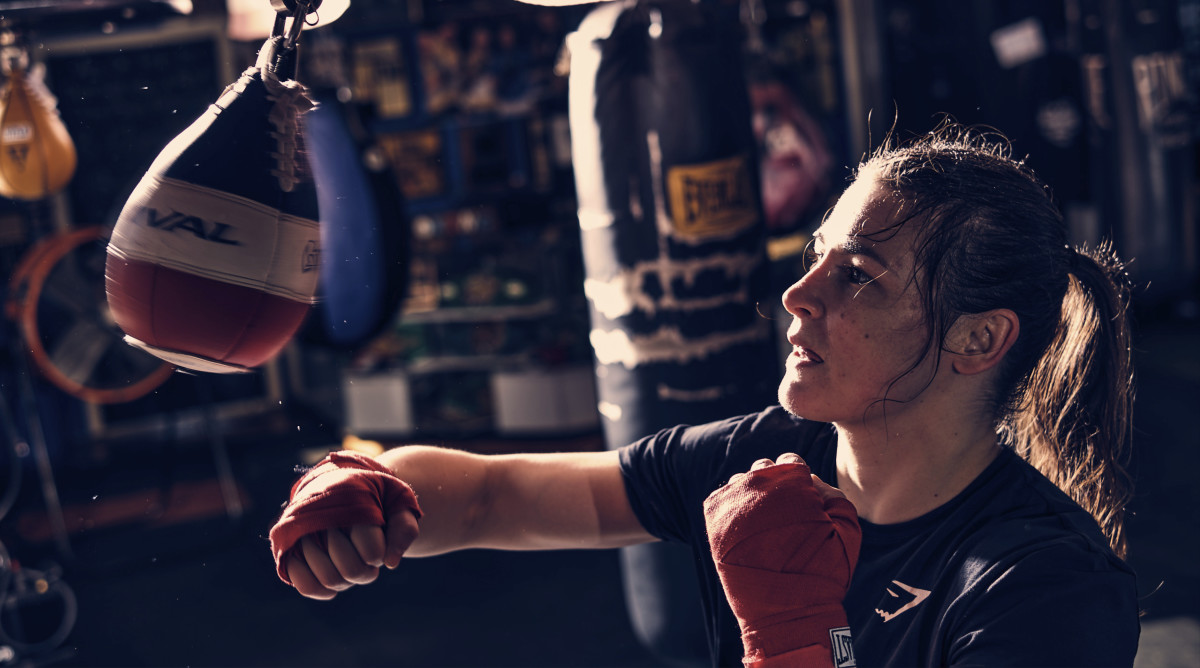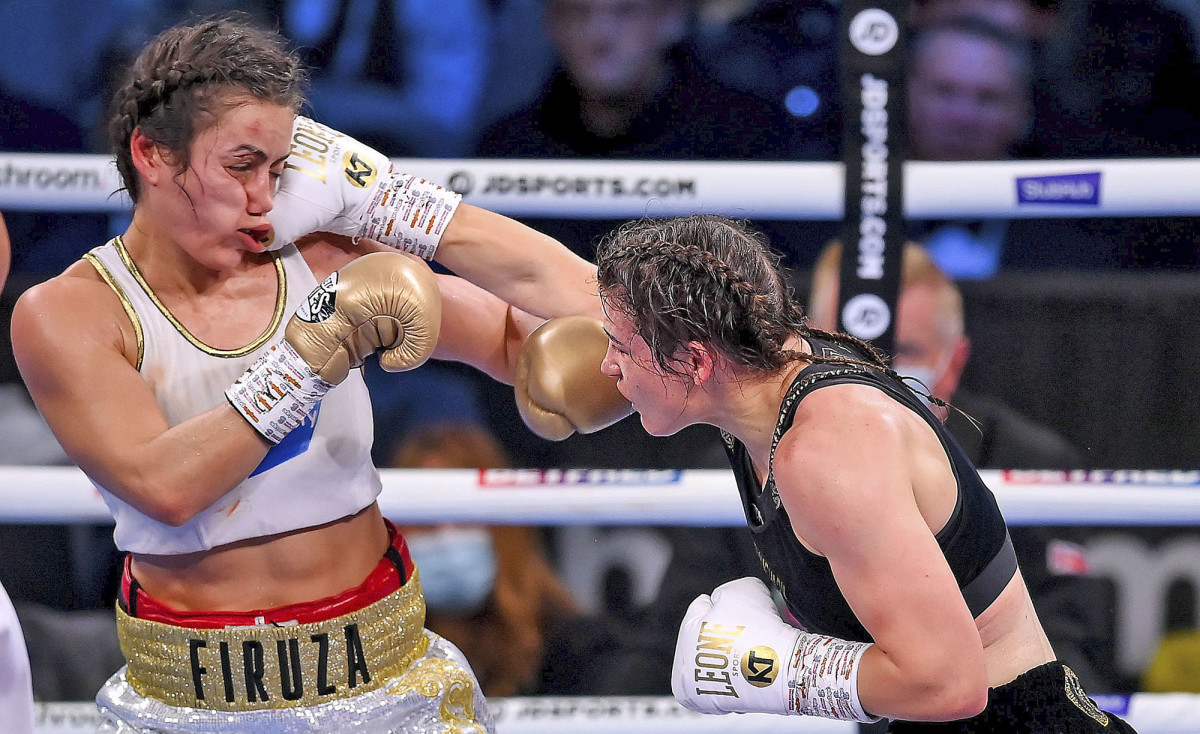Katie Taylor’s Long, Strange Journey

Boxing gyms, renowned for their simplicity, often double as shrines to the elite. In Las Vegas, banners for The Money Team hang under a wall of fight posters at the Mayweather Boxing Club, an unsubtle acknowledgement of Floyd Mayweather’s achievements. Wild Card officially belongs to Freddie Roach, but even the Hall of Fame trainer will concede that it’s the House That Manny Pacquiao Built, with pictures of a triumphant Pacquiao wallpapering Roach’s Hollywood club.
Katie Taylor is the biggest name in women’s boxing, the undisputed champion at 135 pounds, No. 1 pound-for-pound, a box office draw from New York to London. She trains in a nondescript brick building in central Connecticut, beneath a wall-sized mural of “Marvelous” Mykquan Williams, a fringe 140-pound prospect, and opposite a sign inviting fans to a meet-and-greet with even fringier former featherweight Matt Remillard. Evidence of Taylor’s presence is nonexistent. “It would be nice to have one picture,” says Taylor, laughing. “But I’m happy here.”
Taylor, 35, doesn’t need the attention. Doesn’t want it. Hates it, really. Has already had it. There’s the good, the flowery coverage of Taylor’s improbable rise, the daughter of a light heavyweight who fought her way out of an impoverished neighborhood in Ireland to win gold in the 2012 Olympics. And the bad, the split from her father, who doubled as her trainer, that made the intensely private Taylor deeply uncomfortable. An anonymous existence in New England just . . . fits. “Her hobbies are training and shopping on Amazon for training gear,” says Ross Enamait, her trainer. “This environment just suits her.”
Enamait, a 45-year-old reformed investment banker, is why Taylor is in Connecticut. Norfolk-born, Enamait had a decent amateur career that was derailed by a series of hand injuries. He picked up a degree in finance from UConn and entered private life. But the boxing itch stayed with him. After attending the middleweight title fight between Bernard Hopkins and Félix Trinidad in 2001, he started working with amateur fighters. He made training DVDs. He self-published six books. In ’16, Taylor, her career at a crossroads following an early exit at the Olympics, emailed Enamait. She asked whether he would work with her, offering to fly to Connecticut. “She essentially trained herself for the Olympics,” says Enamait, “which was insane.” Enamait liked what he saw and suggested Taylor turn pro. “You could have a fast track,” he told her.

Six years, 20 wins, titles in two weight divisions later, Taylor is still in Connecticut, still with Enamait. On April 30 she will headline at the Garden. “People laughed at me when I said I wanted to be an Olympic champion,” says Taylor. “They never would have believed this.”
Bray, Ireland—population 31,000—is a quiet bedroom community on the commuter line to Dublin. Taylor grew up in Ballywaltrim, a working-class neighborhood, the youngest of four siblings. Her father, Pete, won the Irish light-heavyweight title in 1986. He began training his two sons, Lee and Peter, when they were teenagers. When Katie was 11, she decided she wanted in. “There’s something very addictive about a boxing gym,” she says. “The sound, the smell, the people—I just loved all of it.”
One problem: In the late 1990s, women’s boxing was banned in Ireland. Taylor could train and spar, but there were no sanctioned amateur fights. Behind the scenes, Taylor’s parents—her mother, Bridget, was Ireland’s first female boxing judge—lobbied the Irish Amateur Boxing Association. Taylor, meanwhile, would tuck her hair under her headgear and register at boys tournaments under the name “K Taylor.” Eventually, the Irish authorities relented. In 2001, Taylor, then 15, defeated Alanna Audley in the country’s first official women’s boxing match.

Success followed quickly. Five world titles. Six European championships. In her 20s, Taylor abandoned a promising soccer career (she had been offered several scholarships to U.S. colleges) to focus on boxing. When the Olympics added women’s boxing in 2012—a landmark moment widely credited to public pressure applied by Taylor in the years leading up to it—Taylor stormed to gold in the 132-pound division. Natasha Jonas, an early-round opponent, suggested she couldn’t have beaten Taylor with the benefit of driving a bus into her.
Her ascent seemed unstoppable—until it nearly unraveled. In 2016, Taylor abruptly split from Pete. Taylor declines to get into specifics—in the 2018 documentary, Katie, Taylor references an affair Pete had that led to a separation from Bridget—but calls that time a “low point” in her life. “It was the toughest decision I probably had to make,” she says. “I felt like it was the right decision. And I think my integrity means more to me than anything, and I just felt like I had to make that tough call. But I knew it would cost me, big time.”
It did. Three months before the Rio Olympics, Taylor lost in the semifinals of the world championships, ending her five-year reign. The gym, once a happy place, had become a hollow one; some days she would drive in with tears streaming down her face. Training without her father, says Taylor, was “like missing my right arm.” At the Games, Taylor was eliminated in the quarterfinals.
Critics wondered whether she was finished. Taylor knew she just needed a change. She teamed up with Enamait. “I started to enjoy it again,” says Taylor.
And she sent a DM to Eddie Hearn, the promoter who runs Matchroom Sport. I’ve been seriously considering turning pro the last few months, it read. I think I could do for women’s pro boxing what I did for the amateur sport. Initially, Hearn was skeptical. “Women’s boxing, on a commercial level, didn’t exist,” says Hearn. But he knew Taylor had a global profile. And a fan base. So he signed her.
Her first pro fight, against Karina Kopinska in London, was effectively an audition. “I don’t think Katie knew how much pressure was on her,” says Taylor’s manager, Brian Peters. Taylor stopped Kopinska in the third round. “She f---ing looked unbelievable,” says Hearn. “Sitting in the pocket, ripping body shots.” Equally important: More than 1,000 ticket-paying Irish fans came to support her.
Things moved quickly. She won a title in her fifth pro fight, became a unified champion in her ninth. Wherever Taylor goes, enthusiastic crowds follow. When she fights on undercards, Hearn says, he often worries about how many fans will leave before the main event. Before Taylor, Hearn never considered promoting women’s boxing. Now he has the largest stable of women fighters in the sport. “That’s all because of Katie,” says Hearn. “I don’t think she realizes what she has done for women’s boxing.”
In August 2012, Taylor stood on a dais in Bray, a sea of humanity stretched out in front of her. More than 20,000 supporters packed the Irish coastline to welcome her home after her gold-medal performance. Weeks earlier, at the Olympic boxing venue, Taylor’s fans registered a decibel level of 113.7—the kind of noise normally generated by jet engines. “We don’t have royalty in Ireland,” says Peters. “But Katie is the queen.” Onside, a sponsorship adviser, has named Taylor the country’s Most Admired Sports Personality five years running. In 2018, Conor McGregor popped into Taylor’s locker room after a title defense in Boston and told her it was “an honor” to watch her fight.
Remarkably, Taylor has never fought professionally in Ireland. She declines to address it specifically. Those around her won’t, either. What it boils down to, sources close to Taylor say, is this: MTK Global, a boxing management company founded by alleged drug trafficker Daniel Kinahan, has been heavily involved in boxing in Ireland. A Taylor show in Ireland would have to include MTK fighters. Put MTK fighters on, however, and there is a risk of violence from the company’s rivals. In 2016, several gunmen, dressed as police and carrying assault rifles, opened fire at an MTK weigh-in in Dublin and killed a close Kinahan associate. According to one source, law enforcement officials asked Taylor’s team not to do a show in Ireland, citing the security risk. (MTK announced this month it will cease operations due to the intense scrutiny surrounding Kinahan.) “It’s really sad,” says Taylor. “To go my whole career and not fight in Ireland is very disappointing. But right now it just can’t happen.”
As she prepares for Amanda Serrano, though, Taylor is in a good place. She has reconciled with her father. He isn’t involved with her training—Enamait admits he has never met him—but is, says Taylor, “very supportive. . . . We have a very good relationship.” She is settled in Connecticut after buying a house in Manchester in 2019. And Madison Square Garden will feel like Ireland on April 30. More than 7,500 tickets for Taylor-Serrano were sold in the first week. After initially hoping for a crowd of 10,000, Hearn is buzzing about the possibility of selling the 20,000-seat arena out. The girl who once fought for the right to fight will now have boxing’s biggest stage. “All the sacrifices that I have made along the years are worth just for this moment alone,” says Taylor. “But this isn’t just for myself and Amanda. This is for the next generation of fighters. We are bringing the whole sport up with us. This is exactly the legacy that I want to leave.”
More Boxing Coverage:
• Mannix: Pound-for-Pound Rankings
• Amanda Serrano’s Big Break
• Taylor-Serrano Is Women’s Boxing’s First Megafight
